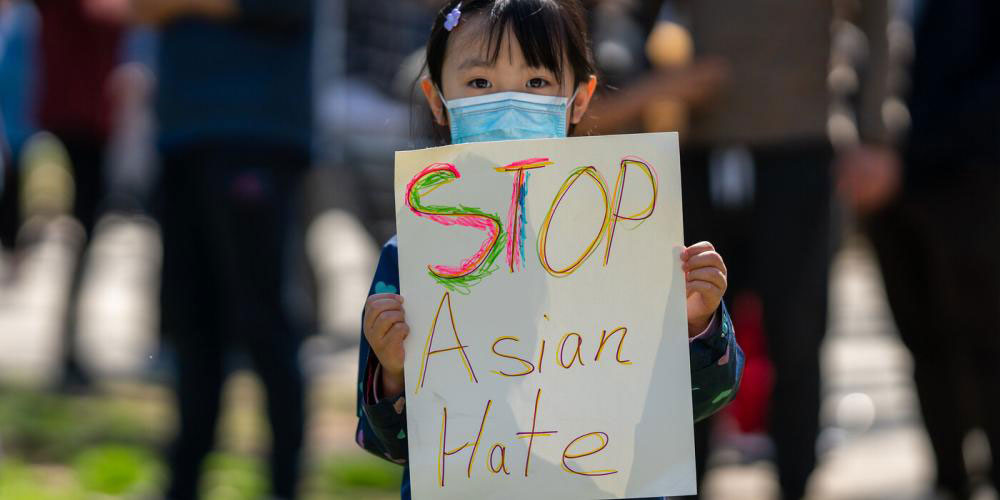How the Media Have Fueled Hate Targeting Asian Americans
March 25, 2021 — Joseph Torres

Flickr user Miki Jourdan
It should not take a mass murder or other acts of violence for communities of color to have their voices heard or their struggles seen.
Over the past week, Asian American and Pacific Islander journalists and thought leaders have had greater presence in the media, providing their insights and context to news stories about last week’s killing of eight people, including six AAPI women, by a 21-year-old white man in Atlanta.
But the events following the shooting also revealed why it has been so difficult for the AAPI community and other communities of color to challenge harmful and racist narratives.
Following the arrest of the gunman, the police quickly claimed that the killings were not racially motivated. Instead, the police said the murderer was “fed up” with his apparent sex addiction, was “at the end of his rope” and was having “a really bad day.”
Initially, many U.S. news outlets quickly amplified the police framing in their coverage.
This angered Naomi Tacuyan Underwood, executive director of the Asian American Journalists Association, who told the Daily Beast that her “rage is personally [due to the] fact that in the early hours of reporting, the shooter’s assertion that it was not racially motivated was given oxygen.” The media’s focus, she said, should have centered on the fact “that there are dead Asian Americans in the wake of an increasing number of hate-crime incidents that started 12 or 13 months ago.”
AAJA published a press release from its Broadcast Advisory Council stating that it had “heard some deeply concerning problems in newsrooms across the country, including in Atlanta.” Asian American journalists were fielding questions like “Are you sure your bias won’t show if you cover the Atlanta shootings?” and “You might be too emotionally invested to cover this story.”
In addition, the AAJA said it has “heard from broadcast members — and from members across newsrooms who volunteered to cover the Atlanta shooting — who have expertise, language skills, and the cultural competency in the community, but were not assigned [stories].” The AAJA also heard from many “members who are the only, or one of few, AAPIs in the newsroom [who] asked for nuanced coverage of the shooting story and [were] rejected.“
So while the voice of a young white mass murderer could be considered credible by the police and the press, the voices and lived experiences of AAPI journalists are questioned or spurned, with skepticism raised about whether they’re able to “objectively” carry out their journalistic duties.
A snapshot of racist anti-AAPI narratives and practices
Since the murder of George Floyd last year, journalists of color have forced several media institutions to reckon with their own racism — and have challenged the myth of objectivity that has been a tool used to silence and control the voices of journalists of color at dominant white media companies.
Throughout our nation’s history, dominant media outlets have created and amplified dehumanizing anti-AAPI narratives that remain pervasive today. And government policies have allowed big media companies — which have played a powerful role in shaping and spreading harmful narratives about the AAPI community and other communities of color — to consolidate our broadcast and cable media infrastructure.
Former President Donald Trump — who in many ways is a media creation — used an anti-Asian trope to describe the COVID-19 virus in an effort to deflect blame for his deadly handling of the pandemic. But Trump’s powerful podium also meant that his racist trope reached a global audience and played a critical role in shaping the cultural conditions — media narratives — that have given rise to AAPI hate.
Just this month, Stop APPI Hate said it had received 3,800 reports of incidents of hate carried out against the AAPI community over the past year — and nearly two thirds of the incidents targeted AAPI women.
Author Jeff Chang wrote in The Washington Post that the former president’s description of the virus is an “update of a very old trope, and a long-offensive one.” He noted that the trope dates back to the 1700s, when Chinese doctors’ “epidemiological drawings of smallpox victims” were viewed in French popular culture as “proof of the superiority of European medicine and the racist notion that the Chinese, as a race, were dirty, sickly carriers of deadly diseases.”
During the mid-1800s, U.S. newspapers dehumanized Chinese immigrants as their numbers increased during the California gold rush. The media’s racist coverage was an effort to deny the Chinese community jobs, economic opportunities and political power.
In 1853, the editor of the Daily Alta California wrote “We have a class here, however, who have most of the vices and few of the virtues of the African and they are numerous in both town and country. We allude to the Chinese. Every reason that exists against the toleration of free blacks in Illinois may be argued against that of the Chinese here.”
In 1854, the New York Daily Tribune called Chinese people “uncivilized, unclean, filthy beyond all conception, without any of the higher domestic or social relations; lustful and sensual in their dispositions.”
These racist narratives provided political support for the passage of the Chinese Exclusion Act of 1882, which was the first U.S. law that placed an immigration ban on a specific nationality.
During World War II, newspapers questioned the loyalty of Japanese citizens and residents and portrayed the community as treacherous foreigners. Papers like The Los Angeles Times supported President Franklin D. Roosevelt’s executive order that placed 120,000 people of Japanese ancestry — the majority of whom were U.S. citizens — in concentration camps.
The paper wrote:
“The time has come to realize that the rigors of war demand proper detention of Japanese and their immediate removal from the most acute danger spots. It is not a pleasant task. But it must be done and done now. There is no safe alternative.”
The paper also defended the placement of Japanese citizens and residents in the concentration camps following calls for the release of those who were detained:
“As a race, the Japanese have made for themselves a record for conscienceless treachery unsurpassed in history. Whatever small theoretical advantages there might be in releasing those under restraint in this country would be enormously outweighed by the risks involved.”
In 2017, The Los Angeles Times acknowledged that “not only was some [of its] reasoning explicitly racist,” but in the paper’s “desperate attempts to sound rational [it actually] exaggerated the severity of the threat while failing to acknowledge the significance of revoking the most fundamental rights of American citizens based solely on their ancestry.”
Earlier this month — prior to the murders in Atlanta — Jeff Chang appeared on a Vox podcast to discuss the history of anti-AAPI violence to provide greater context to the severity of the threat facing the AAPI community today. He noted that Asian-American communities are asking “to be seen” and are raising their voices to call on the public for support — and to “recognize what’s happening.”
“We’re nowhere near being able to crush this kind of narrative of Asian-Americans as being … carriers of disease, as being the sick people that are coming in from outside to corrupt or contaminate our communities,” Chang said. “We have to fight that. We have to be real about what that is and why people are using those type of words against us.”

